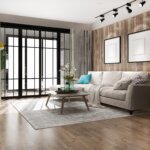Selecting the ideal flooring type for your home is a crucial decision. Two popular options that homeowners often consider are hardwood and laminate flooring. Both choices offer distinct benefits and drawbacks, and comprehending these pros and cons can assist you in making an informed choice. This article will explore five positives and negatives of hardwood and laminate flooring.
Indeed many of us wondered what is better – parquet or laminate. Most often, the deciding factor is the price of these materials, the difference of which is noticeable. Let’s take a closer look at their disadvantages and advantages for a more complete understanding of the question.
Laminate
Laminate is a popular type of flooring that is widely used in homes. It consists of several layers, including a decorative layer that imitates wood, stone or tile texture and look. Here are a few critical features of laminate:
- Ease of installation: Laminate flooring installs fairly quickly and easily thanks to a slat connection system that simply clicks together without the need for glue or nails. This makes it available for do-it-yourself installation.
- Durability: Laminate has good wear and scratch resistance, making it suitable for homes with children or pets. The protective layer of laminate provides additional strength and durability to the flooring.
- Easy to maintain: The laminate flooring is easy to clean and requires minimal maintenance. Its surface is smooth and does not absorb dust or dirt, so you only need to wipe it down regularly with a damp cloth or use a vacuum cleaner to keep it clean.
- Wide range of designs: Laminate offers a wide variety of decorative options, allowing you to choose the flooring that is perfect for your interior. You can find laminate flooring that imitates different types of wood, stone, or tile to create the style and atmosphere you want in your home.
- Moisture resistance: Some types of laminate have higher moisture resistance, making it suitable for use in rooms with high humidity, such as bathrooms or kitchens. However, it’s worth remembering that laminate is still susceptible to damage from standing water, so you should avoid prolonged contact with moisture.
Laminate is a practical and attractive choice for flooring in the home. It combines ease of installation, durability, and various designs, making it popular with many homeowners. Before installing laminate, however, it is essential to consider its features and choose the right type for the specific requirements of your home.
Pros:
- More resistant to external damage than parquet;
- Is not fastidious in care;
- A wide range of surface structures;
- The low price.
Cons:
- Rather cold material;
- Additional soundproofing will require the use of substrate when laying;
- Relatively short service life (although without a heavy load, the operating time can be up to 15 years);
- It is impossible to restore.
Laminate is a durable flooring option that offers resistance to external damage and is relatively easy to care for. It provides various surface textures and finishes to suit different design preferences. Additionally, laminate flooring is often more affordable compared to other flooring types.
Parquet
Parquet flooring is a durable and elegant type of hardwood flooring. It features intricate patterns created by small wooden blocks or strips. Key points about parquet flooring include:
- Aesthetic appeal: It adds sophistication and beauty to any space;
- Durability: It withstands heavy foot traffic and can last for generations;
- Versatility: It comes in various wood species, colors, and patterns;
- Easy maintenance: Regular cleaning and occasional mopping keep it looking its best;
- Restoration potential: It can be sanded and refinished to restore its original beauty.
Potential drawbacks include higher costs and the need for professional installation. Proper acclimation and maintenance are essential to prevent moisture-related issues. Parquet flooring offers a timeless and luxurious option for those who appreciate the beauty of natural wood.
So what can we expect when buying hardwood flooring?
Pros:
- Retains heat well;
- Absorbs sound;
- Can be restored;
- Long service life (about 25 years and more);
- Hypoallergenic;
- Static (does not attract dust).
Cons:
- It can be easily damaged and scratched;
- Requires special care;
- Does not tolerate temperature extremes and high humidity;+
- High price.
Parquet flooring offers several advantages that make it an attractive choice for homeowners. It retains heat well, making it comfortable underfoot and absorbing sound, contributing to a quieter living environment. Parquet flooring can be restored, allowing it to maintain its original beauty even after years of use. It boasts a long service life, typically lasting around 25 years or more, and it is hypoallergenic, reducing the risk of allergies. Additionally, parquet flooring has static properties, minimizing the attraction of dust.
However, there are some drawbacks to consider. Parquet flooring can be easily damaged and scratched, requiring careful maintenance and handling. It is sensitive to temperature extremes and high humidity, which can cause warping or other issues. Additionally, parquet flooring is generally more expensive than other flooring options, which can be a significant factor for some homeowners.
Ultimately, choosing parquet flooring should consider the balance between its advantages and disadvantages. It offers a timeless and elegant look, long-lasting durability, and a range of design options. Parquet flooring can be a luxurious addition to any home with proper care and maintenance.
The Final Word
As we see, these materials have both their disadvantages and advantages
Of course, when choosing hardwood flooring, the cost of repairs automatically ceases to be budgetary, but you get a natural and durable material. On the contrary, laminate for all its disadvantages, can be an excellent alternative to the parquet for less money.
Here, perhaps, it is still worth considering where you want to use a particular material, in what room. Then it will be easier for you to weigh all the factors and make the right decision.


